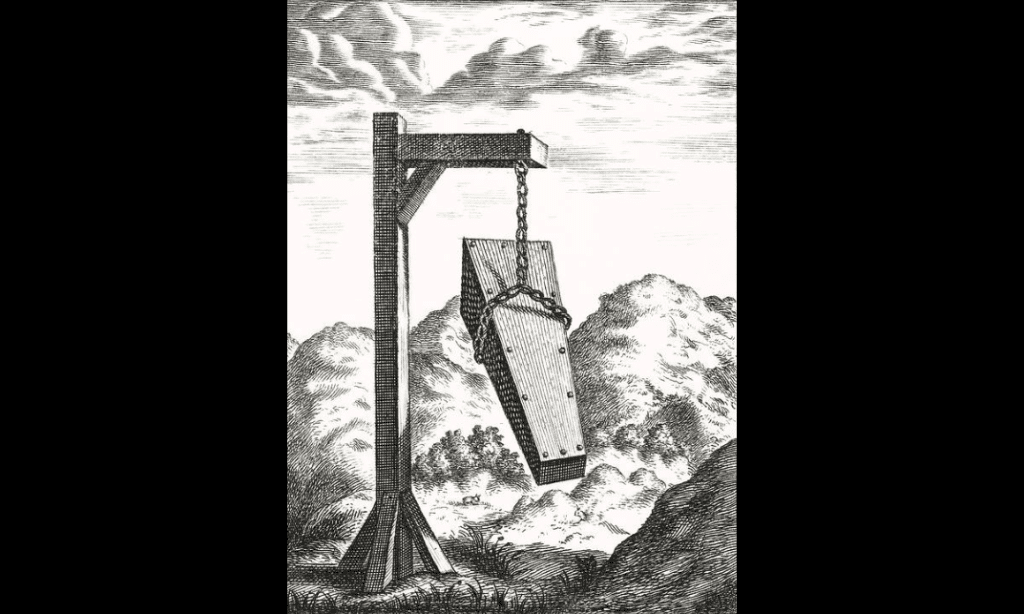May 15, 2023
Permission to republish original opeds and cartoons granted.
Supreme Court sets administrative state’s last stand for 2024 as Chevron deference is sent to the gallows

By Robert Romano
The Supreme Court may be about to strike down the precedent that put the administrative state on a rapid ascent—the 1984 Chevron v. Natural Resources Defense Council decision—that has made executive agencies the primary lawmakers and not Congress as originally envisioned under Article I of the U.S. Constitution.
The case, Loper Bright Enterprises v. Raimondo, will be heard this fall or winter and be decided in 2024, which according to the Supreme Court’s docket posed the following questions: “1. Whether, under a proper application of Chevron, the [Magnuson-Stevens Act] MSA implicitly grants [National Marine Fisheries Service] NMFS the power to force domestic vessels to pay the salaries of the monitors they must carry. 2. Whether the Court should overrule Chevron or at least clarify that statutory silence concerning controversial powers expressly but narrowly granted elsewhere in the statute does not constitute an ambiguity requiring deference to the agency.”
Critically, the Court stated it would only consider the second question on whether or not to overrule Chevron: “THE PETITION FOR A WRIT OF CERTIORARI IS GRANTED LIMITED TO QUESTION 2 PRESENTED BY THE PETITION.” Meaning, the first question on whether the NMFS’ compulsion of domestic vessels to pay salaries of federal monitors was “a proper application under Chevron” will not even be considered.
Known as Chevron deference, the 1984 decision established a legal test whereby federal courts would “defer” to the executive branch’s interpretation of a federal statute so long as it is not an “unreasonable” interpretation. And now it might be about to be struck down.
A year earlier, in a related case in 1983, the Supreme Court similarly and unanimously decided in Motor Vehicle Manufacturers Association v. State Farm Mutual an agency must supply a reasoned analysis when rescinding a regulation. Thus, it is more difficult to eliminate an existing regulation than it is to change it.
Thus, every regulatory rescission is subject to judicial review to determine not only whether it was rational based on the statutory scheme, but to prove that the original regulation exceeded the statute.
Even when there was no basis in law, as in Massachusetts v. EPA, in 2007 the Supreme Court ruled carbon dioxide could be regulated by the Environmental Protection Agency (EPA) under the terms of the Clean Air Act. And that was not even an example where the court was “deferring” to the agency, instead it was ruling in favor of the Commonwealth of Massachusetts.
The Kennedy ruling set the stage for the 2009 carbon endangerment finding by the EPA during the Obama administration, and the Clean Power Plan’s rules on new and existing power plants that defined carbon dioxide as a harmful pollutant under the terms of the Clean Air Act. Based on the 2007 ruling, regulating carbon emissions under the Clean Air Act became a “reasonable” interpretation.
That is, until the Supreme Court’s 2021 ruling in West Virginia v. EPA, that struck down the Environmental Protection Agency’s 2015 Clean Power Plan under the Obama administration that sought to regulate carbon emissions under the Clean Air Act even though the law never contemplated doing so.
The ruling struck down the EPA’s attempt “to adopt on its own such a regulatory scheme” in regulating carbon emissions under the Clean Air Act without Congressional authorization: “Capping carbon dioxide emissions at a level that will force a nationwide transition away from the use of coal to generate electricity may be a sensible ‘solution to the crisis of the day.’… But it is not plausible that Congress gave EPA the authority to adopt on its own such a regulatory scheme in Section 111(d). A decision of such magnitude and consequence rests with Congress itself, or an agency acting pursuant to a clear delegation from that representative body.”
As Roberts ruled, Congress never authorized the EPA to pursue the goal of regulating carbon emissions, writing, “our precedent counsels skepticism toward EPA’s claim that Section 111 empowers it to devise carbon emissions caps based on a generation shifting approach. To overcome that skepticism, the Government must — under the major questions doctrine — point to ‘clear congressional authorization’ to regulate in that manner.”
Showing the stakes, in on May 8, the Biden administration EPA announced in response to the West Virginia ruling its new carbon emission regulation for new and existing power plants — and once again it is citing the 2009 carbon endangerment finding, rooted in Massachusetts v. EPA — with the goal of eventually ending carbon-based electricity generation. They might currently view this as the administrative state’s last stand.
Similarly, in April, the EPA is also proposing a rule that will dramatically expand the agency’s authority to regulate carbon and other emissions from motor vehicles via new tailpipe regulations for light and medium-duty vehicles, and heavy-duty vehicles, with the goal of making such standards unattainable, thereby forcing the nation’s fleet of automobiles to all become electric vehicles.
So, at the same time the Biden administration is seeking to take the nation’s carbon-generating electricity grid offline, it is increasing the burden that will be on that grid by dramatically increasing the number of cars that will need to be powered by it. Does that make sense?
And now, the Supreme Court might be about to kick out one of the final legs of the administrative state stool: Chevron deference. After that, the executive branch simply rescinding regulations that went far beyond what the law ever allowed for should become a far more tenable approach.
The administrative state could be uprooted at long last — a long-standing goal of conservative and Republicans who have sought to restore Congress’ Article I lawmaking powers. A ruling by the Supreme Court could have generations-long implications for how both the lawmaking and regulatory making process is undertaken.
Taken at face value, a ruling overturning Chevron would force Congress to be more specific in the authorities that agencies have and do not have, since expanding the scope of federal powers by executive fiat by reading new powers into the record won’t work anymore.
In the short-term, it could make the regulatory process itself somewhat meaningless: With every new presidential administration that comes in, one of the first things it will want to do is rescind the regulations of the prior administration. Politico’s Josh Gerstein and Alex Guillen worry in a recent piece about this possibility, “Supreme Court move could spell doom for power of federal regulators,” writing, “Undoing the Chevron doctrine would also throw a wrench into Congress’ legislative agenda. In recent decades, lawmakers have increasingly chosen to draft broad guidelines and delegate the technical details to the agencies… In many instances, gridlock has left Congress unable to pass anything at all, leaving aggressive interpretations of decades-old statutes as the only vehicle for presidents and agencies eager to take action.”
So, without Chevron deference, executive branch departments and agencies would appear to lack a “locking” mechanism of sorts with which to keep regulatory schemes in place after a presidential administration leaves office.
Or would they? Interestingly, Congress is considering at this very moment as a party of increasing the $31.4 trillion debt ceiling the so-called REINS Act as a part of the House-passed Limit, Save, Grow Act, which would require Congressional approval in order to enact major regulations. According to a House description of the REINS Act it “Requires and establishes a process for congressional approval of all major rules, defined as rules that would result in an annual impact on the economy of $100 million or more, a major increase in costs or prices, or significant adverse effects on competition, employment, investment, productivity, innovation, or American economic competitiveness.” It excludes monetary policy.
This would dramatically overhaul the rulemaking process — essentially the President and the executive branch would propose rules, and then it would be up to Congress to approve or disapprove them, effectively “locking” expensive regulations into place or otherwise mothballing them.
It poses an interesting dilemma for President Joe Biden, who is weighing his options on what to do about the debt ceiling, that is, which parts of Limit, Save, Grow would be “acceptable” to Congressional Democrats, especially if he believes the Supreme Court is about to overturn Chevron deference. If it does, and Congress does not intervene to create a new rulemaking process that involves Congress, after that, a future Republican or conservative President will be able to rescind regulations all over the place without any votes in Congress.
Whereas now Biden is presented an opportunity to argue around the context of the REINS Act, which appears to acquiesce to the Supreme Court’s current preference that Congress be in the driver’s seat on making laws and regulations.
It is not unprecedented. The 1996 debt ceiling standoff was concluded with a compromise: the 1996 Contract With America Advancement Act that increased the debt ceiling and included the Congressional Review Act, the Line Item Veto Act, the Senior Citizens’ Right to Work Act and the Small Business Growth and Fairness Act of 1996. Of those, the Congressional Review Act created a process whereby Congress could overturn a regulation.
Here, the REINS Act would go even further, requiring Congressional approval for potential economy-breaking regulations. Now, Biden has to consider whether getting Congress involved is preferable to the process a future Republican administration might undertake after Chevron is gone to run roughshod over the administrative state. Meaning, the debt ceiling might be the last, best deal Biden is going to get while the outcome of the Loper decision is still up in the air.
Robert Romano is the Vice President of Public Policy at Americans for Limited Government Foundation.
To view online: https://dailytorch.com/2023/05/supreme-court-sets-administrative-states-last-stand-for-2024-as-chevron-deference-is-sent-to-the-gallows/
Video: U.S. Rep. Byron Donalds Wipes Floor With Smug CNN Hosts

To view online: https://www.youtube.com/watch?v=ziBYkt69T8s
